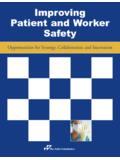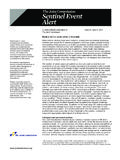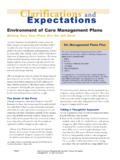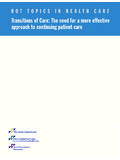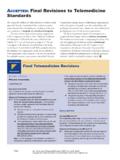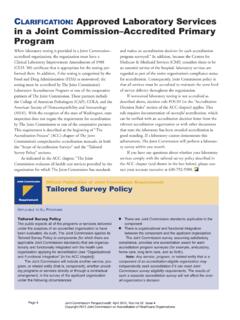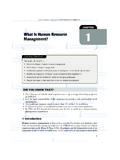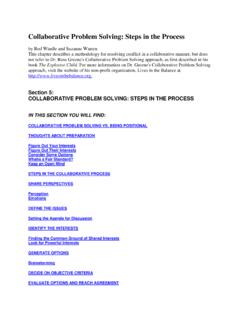Transcription of Patient Safety Systems (PS) - Joint Commission
1 Patient Safety Systems (PS). Introduction The quality of care and the Safety of patients are core values of The Joint Commission accreditation process. This is a commitment The Joint Commission has made to patients, families, health care practitioners, staff, and health care organization leaders. This chapter exemplifies that commitment. The intent of this Patient Safety Systems (PS) chapter is to provide health care organizations with a proactive approach to designing or redesigning a Patient -centered system that aims to improve quality of care and Patient Safety , an approach that aligns with the Joint Commission 's mission and its standards. The Joint Commission partners with accredited health care organizations to improve health care Systems to protect patients. The first obligation of health care is to do no harm. Therefore, this chapter is focused on the following three guiding principles: 1. Aligning existing Joint Commission standards with daily work in order to engage patients and staff throughout the health care system, at all times, on reducing harm.
2 2. Assisting health care organizations with advancing knowledge, skills, and com- petence of staff and patients by recommending methods that will improve quality and Safety processes. 3. Encouraging and recommending proactive quality and Patient Safety methods that will increase accountability, trust, and knowledge while reducing the impact of fear and blame. Quality* and Safety are inextricably linked. Quality in health care is the degree to which its processes and results meet or exceed the needs and desires of the people it ,2. Those needs and desires include Safety . The components of a quality management system should include the following: n Ensuring reliable processes *. The Institute of Medicine defines quality as the degree to which health services for individuals and populations increase the likelihood of desired health outcomes and are consistent with current professional knowledge. Source: Committee to Design a Strategy for Quality Review and Assurance in Medicare, Institute of Medicine.
3 Medicare: A Strategy for Quality Assurance, vol. 1. Lohr KN, editor. Washington, DC: The National Academies Press, 1990. CAMH, January 2021 PS 1. Comprehensive Accreditation Manual for Hospitals n Decreasing variation and defects (waste). n Focusing on achieving positive measurable outcomes n Using evidence to ensure that a service is satisfactory Patient Safety emerges as a central aim of quality. Patient Safety , as defined by the World Health Organization, is the prevention of errors and adverse effects to patients that are associated with health care. Safety is what patients, families, staff, and the public expect from Joint Commission accredited organizations. While Patient Safety events may not be completely eliminated, harm to patients can be reduced, and the goal is always zero harm. This chapter describes and provides approaches and methods that may be adapted by a health care organization that aims to increase the reliability of its complex Systems while making visible and removing the risk of Patient harm.
4 Joint Commission . accredited organizations should be continually focused on eliminating Systems failures and human errors that may cause harm to patients, families, and ,2. The ultimate purpose of The Joint Commission 's accreditation process is to enhance quality of care and Patient Safety . Each requirement or standard, the survey process, the Sentinel Event Policy, and other Joint Commission initiatives are designed to help organizations reduce variation, reduce risk, and improve quality. Hospitals should have an integrated approach to Patient Safety so that high levels of safe Patient care can be provided for every Patient in every care setting and service. Hospitals are complex environments that depend on strong leadership to support an integrated Patient Safety system that includes the following: n Safety culture n Validated methods to improve processes and Systems n Standardized ways for interdisciplinary teams to communicate and collaborate n Safely integrated technologies In an integrated Patient Safety system, staff and leaders work together to eliminate complacency, promote collective mindfulness, treat each other with respect and compassion, and learn from their Patient Safety events, including close calls and other system failures that have not yet led to Patient harm.
5 What Does This Chapter Contain? The Patient Safety Systems (PS) chapter is intended to help inform and educate hospitals about the importance and structure of an integrated Patient Safety system. This chapter describes how existing requirements can be applied to achieve improved Patient PS 2 CAMH, January 2021. Patient Safety Systems . Safety ; it does not contain any new requirements. It is also intended to help all health care workers understand the relationship between Joint Commission accreditation and Patient Safety . This chapter does the following: n Describes an integrated Patient Safety system n Discusses how hospitals can develop into learning organizations n Explains how hospitals can continually evaluate the status and progress of their Patient Safety Systems n Describes how hospitals can work to prevent or respond to Patient Safety events (Sidebar 1, below, defines key terminology). n Serves as a framework to guide hospital leaders as they work to improve Patient Safety in their hospitals n Contains a list of standards and requirements related to Patient Safety Systems (which will be scored as usual in their original chapters).
6 N Contains references that were used in the development of this chapter This chapter refers to a number of Joint Commission standards. Standards cited in this chapter are formatted with the standard number in boldface type (for example, Standard ) and are accompanied by language that summarizes the standard. For the full text of a standard and its element(s) of performance (EP), please see the Appendix. Sidebar 1. Key Terms to Understand n Patient Safety event: An event, incident, or condition that could have resulted or did result in harm to a Patient . n Adverse event: A Patient Safety event that resulted in harm to a Patient . n Sentinel event: A subcategory of adverse events, a sentinel event is a Patient Safety event (not primarily related to the natural course of the Patient 's illness or underlying condition) that reaches a Patient and results in any of the following: o Death o Permanent harm continued on next page . For a list of specific Patient Safety events that are also considered sentinel events, see page SE-1 in the Sentinel Events (SE) chapter of this manual.
7 CAMH, January 2021 PS 3. Comprehensive Accreditation Manual for Hospitals Sidebar 1. (continued). o Severe temporary harm n Close call or near miss, no harm, or good catch: A Patient Safety event that did not cause harm as defined by the term sentinel event. n Hazardous (or unsafe) condition(s): A circumstance (other than a Patient 's own disease process or condition) that increases the probability of an adverse event. Note: It is impossible to determine if there are practical prevention or mitigation countermeasures available without first doing an event analysis. An event analysis will identify Systems -level vulnerabilities and weaknesses and the possible remedial or corrective actions that can be implemented. Becoming a Learning Organization The need for sustainable improvement in Patient Safety and the quality of care has never been greater. One of the fundamental steps to achieving and sustaining this improvement is to become a learning organization. A learning organization is one in which people learn continuously, thereby enhancing their capabilities to create and Learning organizations uphold five principles: team learning, shared visions and goals, a shared mental model (that is, similar ways of thinking), individual commitment to lifelong learning, and Systems In a learning organization, Patient Safety events are seen as opportunities for learning and Therefore, leaders in learning organizations adopt a transparent, nonpunitive approach to reporting so that the organization can report to learn and can collectively learn from Patient Safety events.
8 In order to become a learning organization, a hospital must have a fair and just Safety culture, a strong reporting system, and a commitment to put that data to work by driving improvement. Each of these require the support and encouragement of hospital leaders. Leaders, staff, licensed independent practitioners, and patients in a learning organization realize that every Patient Safety event (from close calls to events that cause major harm to patients) must be When Patient Safety events are continuously reported, experts within the hospital can define the problem, identify solutions, achieve sustainable results, and disseminate the changes or lessons learned to the rest of the PS 4 CAMH, January 2021. Patient Safety Systems . hospital. In a learning organization, the hospital provides staff with information 4-8. regarding improvements based on reported concerns. This helps foster trust that encourages further reporting. The Role of Hospital Leaders in Patient Safety Hospital leaders and staff provide the foundation for an effective Patient Safety system by doing the following:9.
9 N Promoting learning n Motivating staff to uphold a fair and just Safety culture n Providing a transparent environment in which quality measures and Patient harm events are freely shared with staff n Modeling professional behavior n Addressing intimidating behavior that might undermine the Safety culture n Providing the resources and training necessary to take on improvement initiatives For these reasons, many of the standards that are focused on the hospital's Patient Safety system appear in the Joint Commission 's Leadership (LD) standards, including Standard (which focuses on having an organizationwide, integrated Patient Safety program within performance improvement activities). Without the support of hospital leaders, hospitalwide changes and improvement initiatives are difficult to achieve. Leadership engagement in Patient Safety and quality initiatives is imperative because 75% to 80% of all initiatives that require people to change their behaviors fail in the absence of leadership managing the Thus, leadership should take on a long-term commitment to transform the Safety Culture A strong Safety culture is an essential component of a successful Patient Safety system and is a crucial starting point for hospitals striving to become learning organizations.
10 In a strong Safety culture, the hospital has an unrelenting commitment to Safety and to do no harm. Among the most critical responsibilities of hospital leaders is to establish and maintain a strong Safety culture within their hospital. The Joint Commission 's standards address Safety culture in Standard , which requires leaders to create and maintain a culture of Safety and quality throughout the hospital. CAMH, January 2021 PS 5. Comprehensive Accreditation Manual for Hospitals The Safety culture of a hospital is the product of individual and group beliefs, values, attitudes, perceptions, competencies, and patterns of behavior that determine the organization's commitment to quality and Patient Safety . Hospitals that have a robust Safety culture are characterized by communications founded on mutual trust, by shared perceptions of the importance of Safety , and by confidence in the efficacy of preventive Organizations will have varying levels of Safety culture, but all should be working toward a Safety culture that has the following qualities: n Staff and leaders that value transparency, accountability, and mutual n Safety as everyone's first n Behaviors that undermine a culture of Safety are not acceptable, and thus should be reported to organizational leadership by staff, patients, and families for the purpose of fostering risk ,10,12.
